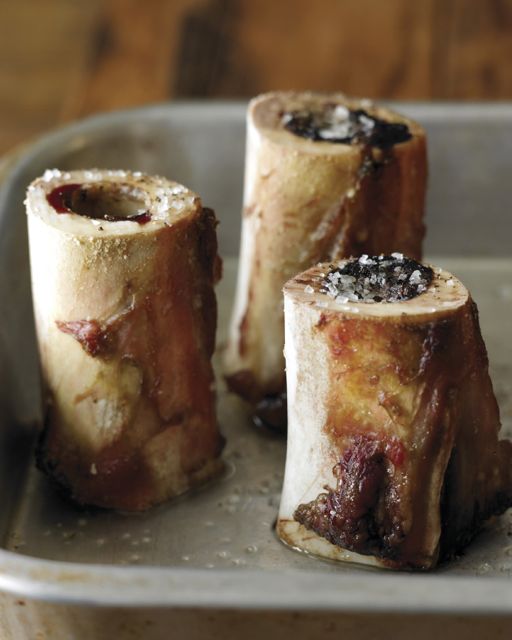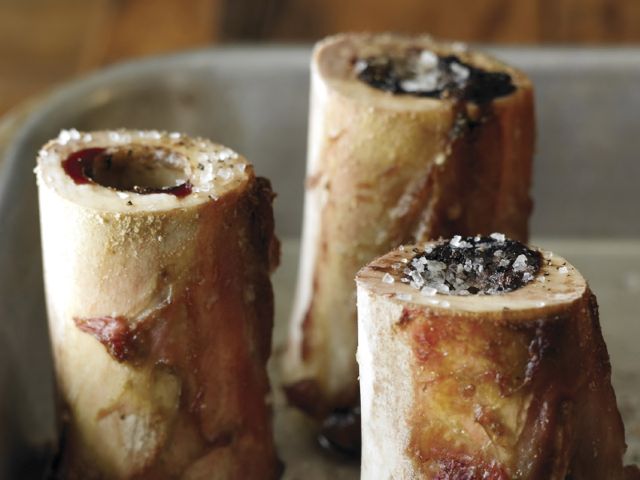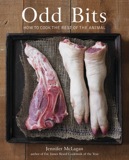
marrow, l
(article, Jennifer McLagan)
[%pageBreakSettings nobreak=true][%adInjectionSettings noInject=true] h3. From the section titled "Getting to the Marrow" While all animals have marrow in their bones, birds have less, because many of their bones are hollow so that they can fly. Veal and beef marrow are the most popular because of their very mild flavor and the higher ratio of marrow to bone. Marrow is more versatile than you might think. Apart from eating it straight from the bone, you can use it like you would any other fat, adding it to dumplings, hamburgers, and dessert. It is also an excellent fat for sautéing and frying. There is another type of animal marrow that is less common; this is the pith or spinal marrow. This is found in the spinal column, and it's the marrow you see in neck and oxtail slices. It is edible and is usually enjoyed with the meat and bone rather than separately. h4. How to choose Veal and beef marrow are the most popular, as bovine leg bones contain the most marrow. The bones can be cut to any length you want; ask your butcher for pieces cut from the center of the leg bone, where the ratio of marrow to bone is highest. Make sure the marrow is accessible at both ends of the bone, especially if you plan on extracting the marrow before cooking. [[block(sidebar). h1. About the book and author [/books/collections/allbooks/oddbits "Odd Bits: How to Cook the Rest of the Animal"] removes the mystery of cooking marrow and those other parts of the animal that most people overlook, such as kidneys, tripe, liver, belly, cheek, and shank. An Australia-born chef, Jennifer McLagan is the author of Bones and Fat, both winners of IACP and James Beard awards. Reprinted with permission from Ten Speed Press, a division of Random House, Inc. Copyright © 2011. ]] It is hard to judge how much marrow you will get from any bone, and it ranges widely depending on the thickness of the bone. A 3-inch bone will yield anywhere from 3/4 to 3 ounces, but usually it averages around 1 1/2 ounces. Buy extra bones to be sure you have enough. Bone marrow freezes well in or out of the bone. You can also have the bones cut lengthwise. This makes the marrow easy to get at with any spoon — no need for a silver Georgian one. The bones should already be free of meat and should smell clean and faintly meaty. The marrow itself should be whitish-pink in color. Don’t worry if you can see blood spots on the surface of the marrow; that’s normal. h4. How to prepare and cook There are various methods to extract raw marrow from the bones. Recently, I learned a new one from my friend the chef Albert Ponzo. I now use this method all the time, but the marrow must be accessible at both ends of the bone. Leave the marrow bones on the counter at room temperature for about 15 minutes; the marrow should just begin to soften slightly. Now run a small, flexible knife between the marrow and bone at each end, to free the marrow from the bone as much as possible. Pick up the bone and, using your thumb, push the marrow from the thin end toward the fat end out of the bone. Don’t start at the thick end. The marrow will be soft and will tend to squish under the force of your thumb, but persist and eventually the marrow will emerge from the bone in one piece. [%image marrow float=right width=300 caption="Roasted marrow bones from 'Odd Bits.'"] If the bones are cut lengthwise, run a knife along either edge of the cut bone, and let sit at room temperature until slightly softened; then ease the marrow out. To remove the blood from the marrow, place the marrow bones or extracted marrow in a bowl of ice water with 1 teaspoon of coarse sea salt per cup of water. Refrigerate for 12 to 24 hours, changing the water 4 to 6 times and replacing the salt each time. Drain and refrigerate until you are ready to cook the marrow. Use within 24 hours or freeze the drained marrow bones or marrow for up to 3 months. To roast marrow bones, drain them, pat the bones dry, and place them standing up or cut side up in a roasting pan in a preheated 450-degree oven. Roast them for 15 to 25 minutes, until the marrow has puffed slightly and is warm in the center. [[block(sidebar). h1.Featured recipe]] To test, insert a metal skewer into the center of the bone, then touch it to your wrist to gauge the marrow’s temperature. There should be no resistance when the skewer is inserted, and some of the marrow will have started to leak from the bones. Always serve roasted bone marrow very hot.

marrow, l

feature-image, l

featurette-image, l

promo-image, l

reference-image, l

newsletter-image, l